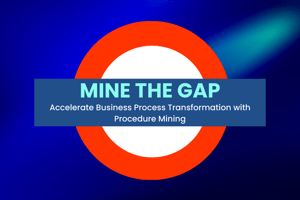scenario modeling process mining event logs
An Introduction to Process Mining from BusinessOptix
What is process mining?
On your journey to improve your business processes, you need to understand where you are today. This can be achieved manually using workshops and observations to model your processes – or you can use process mining to create an accurate and objective picture!
Taking the manual approach can lead to personal views of how people ‘think’ processes run, while the process mining approach will lead to a fuller and more accurate representation of the end-to-end process, including the wide array of variations and nuances.
As Professor Pedro Robledo[i] says, process mining allows “a party to extract information from event and transaction logs to discover models that describe processes … so it reduces the time necessary to model a process that is then optimized and automated in BPM”.
In short, process mining uses the operational data (date, time, user, activity, object, etc.) stored in your system event logs to uncover what actually happens. This detailed insight provides an accurate view of process flows and performance that support improvements and new process development.
How does process mining work?
Using data and insights generated from your event logs, process mining allows you to identify constraints, prioritize improvement opportunities and pre-empt compliance and regulatory issues.
With a detailed visualization of your actual processes you can see the paths and flows along with frequency, wait time, bottlenecks, exceptions/deviations, statistics, variances, costs, compliance issues, inconsistencies, etc. Process mining has the ability to highlight things you may never have known or thought about.
From here you can investigate and identify problem areas such as staff training issues, system capacity, resource constraints, quality issues, poor process design, under staffing, staff rule breaking, missed compliance, inconsistencies, and so on.
With a clear view of the problem areas to focus on, you can use scenario modeling and simulations to create and bring to life alternative flows and resource utilization models that address the identified problems.
Used continuously, process mining is able to repeat this cycle so the organization is constantly improving its processes in line with transformation and operational efficiency initiative goals.
How will process mining help you improve operational performance?
As a process owner, engineer or analyst; transformation lead or consultant, or compliance or audit officer responsible for process analysis and improvement, process mining is a game changer. It provides a set of powerful tools that enable non-technical people to:
- Create fact-based business cases (including the problem and potential solutions) to drive change,
- Deliver continuous process improvements, optimizations and compliance, and
- Create and monitor process performance metrics (incl. KPIs and SLAs)
Wherever process data exists, process mining is able to support improvement in use cases. For instance:
- Financial operations: identify and eliminate delays in payment processes to reduce debtor days and improve working capital
- Customer service: identify and eliminate or automate process steps to make solving customer problems faster for the customer (and contact center agents)
- Customer experience: identify and eliminate friction in customer journeys to improve satisfaction, retention and product usage
- Compliance: identify and eliminate inconsistent processes to ensure fully auditable compliance with regulations
- HR: identify and eliminate delays in onboarding to improve the new employee experience
- Manufacturing: identify and eliminate bottlenecks in manufacturing processes to improve resource utilization
- Retail: identify and eliminate poorly designed supply chain flows to improve distribution and stock replenishment from the warehouse to the shop floor or delivery
- Standardization: identify and eliminate non-standard process so everyone is working in the most efficient and effective way
Process mining gives you the information needed to discover and investigate issues like these in business process. Coupling this with your own understanding of your processes, industry and relevant regulations and standards allows you to use scenario modeling and simulations to identify opportunities for improvement and compliance that will transform the process for the better – all based on actual data that supports better decision making.
Going a step further, while going through the above phases you will have gathered knowledge that can be used to support the creation and rollout of supporting documentation such as work instructions for frontline staff and/or step-by-step guides for customers.
What should you consider when getting started with process mining?
When getting started with process mining consider the processes, the supporting systems, required metadata and data access.
Processes: which process (or processes) are you looking to analyze?
- Most processes could justify process mining but there is an argument for focusing on those that are more complex and have a high transaction count.
Systems: is the process supported end-to-end (or to a fairly significant extent) in one or more systems?
- If the process is primarily supported by systems (in that a system is used to action and record the majority of the potential activities that a transaction can follow) then it is a strong candidate.
Meta-data: do your system(s) record a Case ID, an Event Identifier, a Timestamp and (useful but not mandatory) a Resource/Role for each transaction or case?
- With the above data in the log file(s), you can carry out process mining.
Data access: are the system event logs accessible to you?
- Information systems support business processes in most organizations. These systems, with some exceptions, record and log data about those business processes. Most modern business systems log data about these business processes in a structured way, recording what was done, when and by whom. This is the data you need to discover process models, and all the metrics and meta-data behind them.
What process mining terminology should you know?
Here are a number of key terms and phrases that will help you navigate around the world of process mining.
Case: each transaction, usually represented by an ID of some kind, is a case.
This could be:
- A unique system ID
- A transaction reference (PO Number, Case Number, Ticket Number, etc.)
Events: the events or activities that take place through the lifecycle of each transaction.
This could be:
- Create Ticket, Create Purchase requisition, etc.
Time stamps: a record of when each event took place.
This could be:
- A timestamp of a status change (representing the event)
- A start date and time, and a separate end/complete date and time
Variants: each unique potential path a case can take through a process.
Additional Meta-data: any additional useful data that is recorded and can be used to better analyze the process.
Examples include:
- Supplier: this can help identify or analyze suppliers who are more effective, or where SLA’s are being breached
- Product or location: these can help identify the reasons for variations in a process
- Resource: this can help identify resources which are more or less effective or more or less compliant
How can BusinessOptix help you mine your processes?
BusinessOptix Process Transformation suite includes capabilities to help you mine and improve your processes. Key capabilities will help you to:
- Mine event logs to quickly discover a data driven view of current state process flows
- Identify improvement opportunities that will deliver the most value
- Leverage scenario modeling and simulation to test different paths for change
- Select and implement preferred options and roll these out
- Continuously mine processes to ensure they are delivering the intended results, whilst identifying new areas for transformation
In mining and creating your future processes BusinessOptix will have captured a base of knowledge that can be used to create a more well-rounded view of your operations. All of this knowledge can be used to support your overall business through creating documentation, proving compliance and providing insights to support better decision making.
How can you find out more?
As Gartner[ii] say, “improve visibility and understanding of the actual performance of business operations and processes, by investing in process mining”.
- Want to know more about process mining?
- Want to explore its potential in your organization?
- Want to see how it works?
References:
[ii] Gartner Market Guide for Process Mining, Marc Kerremans, 17th June 2019



